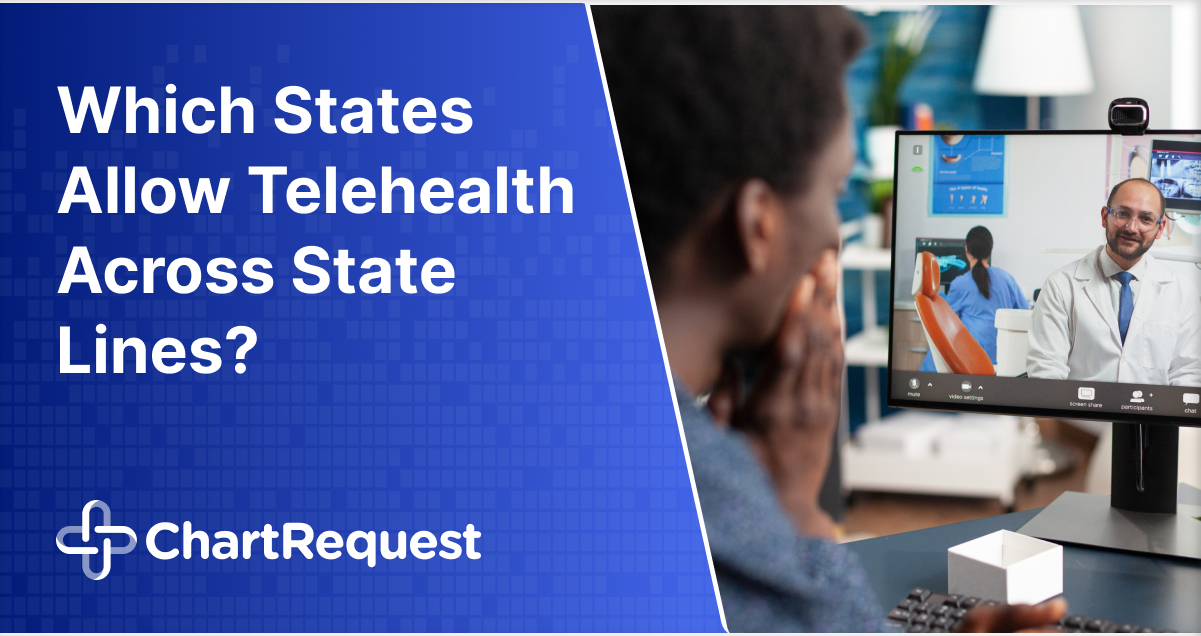Which states allow telehealth across state lines?
Like many healthcare regulations, each state in the U.S. may have unique rules regarding telehealth. These may be permanent state statutes or temporary rules when needed most.
In this article, we’ll dive into the ins and outs of offering telehealth across state lines.
As medical record exchange specialists, we can also support your practice with software and services that help you offer informed care in-person or over the internet.
What Is Telehealth?
Telehealth, also called telemedicine, is a fairly new method of providing healthcare services using voice or video calls.
In essence, telehealth encompasses a range of technologies and tactics to deliver virtual medical, health, and education services.
Here’s why telehealth shines in today’s digital age:
- Convenience: Patients no longer need to travel long distances for routine check-ups or follow-up visits. Just a few clicks can connect them to their healthcare provider.
- Efficiency: Physicians often see an average of 20 patients per day, spending approximately 20 minutes with each. Telehealth can reduce no-shows and cancellations.
- Accessibility: More than 60 million Americans live in rural areas. These residents may struggle to access care due to distance, transportation issues, and a shortage of healthcare providers.
Integrating telehealth helps healthcare providers uphold a high standard of patient care while addressing the growing demands for convenience and accessibility.
What Are Telehealth State Regulations?
State regulations are critical to compliant telehealth services, but they can be confusing to navigate. These regulations can significantly influence how healthcare providers deliver remote care services.

Before investigating which states allow telehealth across state lines, there are a few important things to note.
The Impact of State Regulations on Telehealth Services
State regulations can dictate several key elements of telehealth, including:
- Licensure: Most states require healthcare providers to be licensed in the state where the patient is located. This means a doctor in California may need a separate license to treat a patient in Nevada via telehealth.
- Reimbursement: How and whether insurance companies reimburse telehealth services can also vary, affecting the adoption and sustainability of telehealth programs.
- Standards of Care: States may have different expectations regarding the quality and scope of services delivered through telehealth.
Licensure Compacts and Agreements
Licensure compacts and agreements can simplify telehealth across state lines, easing the burden of obtaining multiple state licenses.
The Interstate Medical Licensure Compact (IMLC), for example, is a significant stride toward simplifying this process for physicians. Joining the compact allows eligible providers to obtain licenses to practice in multiple member states.
States with Permanent Policies Regarding Telehealth Across State Lines
Some states have adopted permanent policies that invite telehealth services from other states. Examples of states with these policies include:
- Arizona: The Arizona Board of Behavioral Health Examiners does not restrict which license types can practice telehealth.
- Oregon: Out-of-state physicians must acquire active telemonitoring status through the Oregon Medical Board before they can perform intraoperative telemonitoring.
- Texas: Permits out-of-state health professionals to provide telehealth services as long as they’re licensed and in good standing in their state.
- Florida: Has Telehealth Provider Registry lets out-of-state providers treat Floridian patients without a Florida license, as long as they register and meet specific criteria, such as:
- Healthcare professionals must hold a valid, unrestricted license in their home state, approved by the Florida board for their healthcare profession.
- Candidates must have a clean, professional record without any disciplinary actions that could affect their eligibility.
- Prospective telehealth providers must actively enroll in the Telehealth Provider Registry maintained by the Florida Department of Health.
- They should adhere to Florida’s standard of care requirements and prioritize patient safety as they would with in-person services.
- Maintaining professional liability coverage or demonstrating financial responsibility per Florida requirements is crucial.
States with Temporary/Emergency Policies
When faced with public health emergencies, certain states temporarily open up for out-of-state telehealth providers.
- California: During the COVID-19 pandemic, out-of-state medical personnel could assist under certain emergency conditions, recognizing the need for additional support.
- New York: Permitted out-of-state licensed telehealth providers to offer services without a New York license during emergency declarations.
States with Restrictive Policies
Some states enforce stringent policies for crossing state lines, virtually or otherwise.
- Arkansas: Firm out-of-state telehealth providers are welcome only if they have obtained full licensure within the state. No shortcuts here.
- Alabama: The state insists that any provider wishing to offer telehealth services to its residents must be fully licensed by the relevant Alabama state board.
Spotlight on Specific Requirements
Some states have unique quirks in their out-of-state telehealth regulations.
- Alaska: Known for its wilderness, it also requires mandatory reporting on telehealth activity from out-of-state providers—talk about keeping an eagle’s eye on things!
- Colorado: The telehealth consent decree in Colorado is interesting. Before delivering services, providers must obtain patient consent, specifically acknowledging that telehealth services will be performed from another state.
Best Practices for Telehealth Providers Across State Lines
Telehealth can be challenging for healthcare providers who offer or plan to offer these services. Following established best practices will help you stay compliant with state regulations while delivering top-notch care.
Here are some best practices you can follow as a telehealth provider:
Staying Compliant
- Know Your Regulations: Stay updated on the laws and guidelines in each state where you provide services.
- Licensure is Key: Ensure you have the proper licensure for each state if mandatory.
- Secure Patient Data: Use secure platforms for all telehealth interactions and document exchanges.
Delivering Quality Care
- Clear Communication: Be transparent with your patients about the telehealth process, what they can expect, and how their data is protected.
- Patient Consent: Always obtain informed consent specifically for telehealth services.
- Technical Check: Ensure both you and your patients have a good understanding of the technology used.
- Follow-Up: Just like in-person visits, follow up with your patients to address any concerns and assess their progress. It shows you’re on this journey together, even if it’s through a screen.
Simplify Medical Record Release
As with all healthcare, the fast exchange of medical records helps providers offer informed care. This is where ChartRequest becomes handy for providers who offer telehealth services. Benefits include:
- Dedicated Compliance: ChartRequest monitors updates to federal and state laws that affect the release and retrieval of medical records.
- Secure Data Transfer: Our military-grade security features and unbreakable encryption protect sensitive data and mitigate breach risk.
- Unified Portal: ChartRequest centralizes all record requests on a single, streamlined portal. This makes it easy to keep track of request progress and prevent right of access issues.
- Audit Trails: Automated audit trails track each interaction with every request and strict access controls limit who can see what.
- Speed and Efficiency: We help you spend less time on paperwork and more time with your patients.
Embracing Telehealth? Let ChartRequest Simplify Record Exchange
Knowing which states allow telehealth across state lines will help you stay compliant and boost the impact of your telehealth services.
While we do not offer direct telehealth services, our platform helps telehealth providers offer informed care. To maximize the benefits of telehealth, consider upgrading your systems for releasing and retrieving medical records with ChartRequest.


